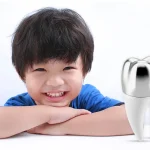
Pediatric crowns are dental restorations used to protect and strengthen children’s teeth that have been weakened by decay, injury, or developmental issues. These crowns cover the entire tooth and provide stability for chewing and speaking. Parents often hear about them during dental visits, so it is helpful to know how they work and what they achieve.
Materials used in crowns:
Crowns for children are made from different materials. Stainless steel crowns are durable and often recommended for back teeth, as they withstand chewing forces. Tooth-colored pediatric crowns Dubai are another option, offering a more natural appearance for front teeth. The choice depends on the tooth’s location and the extent of damage.
Purpose of pediatric crowns:
The main purpose of a pediatric crown is to preserve a tooth that is too damaged for a filling. Instead of removing the tooth, a crown protects it until it naturally falls out to make space for the permanent one. This approach supports normal growth, alignment, and oral function.
Procedure for placement:
The procedure for fitting a crown is usually straightforward. The dentist first removes decay and shapes the tooth to hold the crown securely. After preparation, the crown is adjusted and placed over the tooth to provide full coverage. Once in place, it acts like a shield, protecting the tooth from further damage.
Benefits for children:
Pediatric crowns maintain chewing function, speech clarity, and alignment. They reduce the risk of early tooth loss, which might affect how permanent teeth grow. By safeguarding damaged teeth, crowns help children maintain natural oral development and prevent complications later.
Aftercare and maintenance:
Caring for pediatric crowns involves regular brushing, flossing, and routine dental check-ups. Parents should also watch their child’s diet, as sticky or hard foods may damage the crown. Teaching good hygiene habits early supports the crown’s durability and promotes healthier permanent teeth as they come in.
When crowns are suggested:
Crowns are suggested for teeth that have extensive decay, have undergone a pulpotomy or pulpectomy, or are fractured due to injury. In these cases, a crown is more reliable than a filling because it provides stronger protection and longer-lasting stability for the tooth.
Pediatric crowns are practical dental restorations that preserve children’s teeth until they are naturally replaced by permanent ones. They protect oral health, support normal function, and reduce the risk of further dental issues. Parents who learn about the purpose, types, and aftercare of crowns gain reassurance about this treatment for their child.
 6 Ways Industrial Lubricant Distributors Support Industrial Growth
6 Ways Industrial Lubricant Distributors Support Industrial Growth  What Small Companies Gain From ISO 14001 Consultancy
What Small Companies Gain From ISO 14001 Consultancy  The Ways In Which Home Elevators Improve Accessibility
The Ways In Which Home Elevators Improve Accessibility  What Parents Should Know About Pediatric Crowns
What Parents Should Know About Pediatric Crowns 


